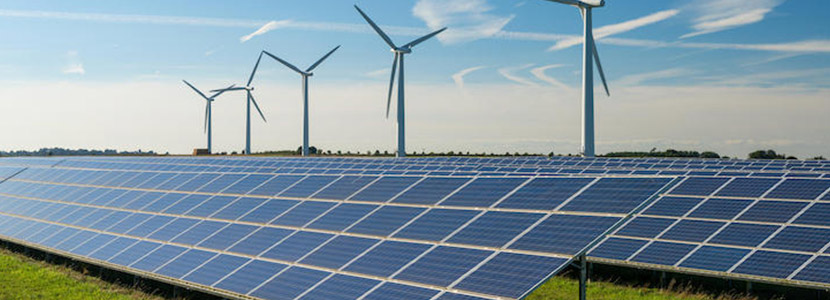
Climate change is a real threat to our planet, and if humanity does not change the appetite for industrial growth, then we should significantly reduce carbon emissions to avoid potentially harmful results for the world. However, this transformation process should not be done suddenly, it is a matter that must be fully defined in all its dimensions and impacts on the sustainability of the planet and its human, environmental and economic pillars, which are of equal value for the future. of the planet.
To significantly reduce carbon emissions, there are great challenges and also the danger of rushing without planning and rigorously implementing this transition process that the market is not recognizing, and we could reach a point where the potential perfect medicine is worse than disease. Particularly when the market is targeting falsely instant renewable energy solutions.
Recently, the State of California (USA), the fifth largest economy in the world, after having made the decision with great fanfare to supply the state’s energy demand with solar energy, has been forced to open five natural gas plants to abolish the Potential risk of total system blackouts, which would have very negative consequences for the entire State and its population. Therefore, if these dangers materialize, they would have very critical effects as they do not have a reliable energy basket.
Talking about a sustainable energy transition goes beyond a change in the energy source and stop, in the short term, using fossil resources. The reason why the world still needs oil and gas, where total abandonment in the use of these resources cannot be claimed, is that according to the University of Oxford, for the year 2019 the consumption of oil and gas represented 30.93% and 22.67% respectively in the total available primary energy consumed, while solar, wind and hydroelectric energy generated 9.1% of the total.
Regarding the future of the hydrocarbon industry, while Goldman Sachs points out that the demand for oil will grow until at least 2030, the International Monetary Fund assures that it will reach its peak around 2040. From this perspective, a period is an estimated transition from liquid fuels to only gas, which could last many more years as renewable energies mature in their technical, environmental and economic dimensions.
Having said that, the quote from the US Energy Information Administration stating that liquid fuels will account for roughly 35% of total US energy consumption in 2050, compared to 37% in 2019, is surprisingly surprising. , a very marginal decrease.
The transition to renewable energy will require a very critical intensification in the extraction of rare earth metals and minerals, with real environmental and social costs that could impact the planet more lethal than current levels of CO2 emissions. This is why it is vitally important to think in the sense of energy sustainability for the world and for our country in particular, from the coexistence between hydrocarbons and renewable energy sources, and not from the elimination of one of these.
Each country has very particular circumstances in its energy baskets, types of industry, challenges, risks, emissions and in its economies in general. Therefore, applying the same model of methodology and schedule for the energy transition in all countries can be as wrong as not recognizing that the energy transition has already begun and is here with all the implications that it entails.
There is a very clear correlation between economic growth, primary energy consumption and increased C02 emissions. As our country continues its economic development, it is to be expected that primary energy consumption will increase and emissions will increase. Colombia already has a very clean energy matrix, since 25% of primary energy consumption comes from renewable sources such as hydroelectricity. In the world, the point of arrival for many countries is to have a cleaner energy basket as we have today in our country.
According to the EIA, Colombia produces 0.25% of primary energy emissions in the world, with 0.6% of the world population. So cutting this amount in half, as many claim, could move the needle on this Global KPI a little bit, but it would substantially restrict the country’s ability to grow and develop. Colombia produces 290M Teq per year of CO2, of this amount, 30% comes from the energy sector, the other 70% comes from other industrial sectors such as agriculture, livestock, forestry and other land uses.
Ecopetrol in its recent report on energy transition and decarbonization states that, between 2010 and 2020, it has managed to reduce emissions by 8.4M Teq of CO2. The Government has committed to reducing 170M Teq per year of CO2 by 2030, compared to almost 291M Teq of CO2 per year in Colombia in 2020, and does not clearly establish how it will get there.
The questions would be: In what way will we grow as a country with respect to 2020? What will be the impacts on national sustainability to achieve it? Will we apply the same type of emission reduction measures that are thought to be applied in the Colombian hydrocarbon industry in all other sectors of the country?
It is critical that the energy industry participate in this discussion, because this sector is a fundamental pillar for the growth of the national economy, and also, it is the main protagonist of sustainable energy coexistence towards a better future for Colombia. Therefore, we must consciously and responsibly safeguard and accompany the current energy transition.
It is clear then that, for many years, hydrocarbons will be a large part of the energy basket worldwide, that the sector is and will be the protagonist of the energy transition and that gas will be the longest-lived hydrocarbon in this transition, not only because of its characteristics. current, but because of this being also the raw material for a clean fuel with a high energy capacity such as hydrogen.
In the world, proven gas reserves are 6,642 trillion cubic feet (TPC). The Middle East being made up of Iran, Iraq, Israel, Kuwait, Oman, Qatar, Saudi Arabia, Syria, United Arab Emirates and Yemen, who have the largest amount of reserves, approximately 2,677 TPC, which is equivalent to 40% of total reserves of the planet.
According to the International Energy Agency, natural gas will maintain its role in the future of sustainable energy. The participation of this fuel in the energy matrix will increase to 25% by 2040 and will grow at a rate of 1.2% annually between 2030 and 2040. The above coincides with the trends in Colombia, where natural gas will reach 22% by 2050 in the country’s energy matrix.
In the case of Colombia, the 1P gas reserves are almost three TPC and with a self-sufficiency of 7.7 years. In addition, according to the latest report from the Ministry of Mines and Energy, commercialized gas production in Colombia was 1,122 million cubic feet per day (mcfd), a figure that translates into a recovery of 20.3% compared to what recorded in the same month of 2020 (932 mpcpd), and compared to June 2021 (1,065 mpcpd), production had an increase of 5.3%.
Natural gas today plays a key role in the transition to renewable energies and in overcoming energy poverty. Colombia has a potential of 54 TPC of gas reserves, of which 30 would come from offshore projects and 24 from unconventional fields, which are currently located mostly in the Middle Magdalena Valley.
In addition, gas will promote the transition to hydrogen, an energy source that motivates decarbonization strategies, since it is a clean fuel and also produces more energy per kilo than any other. Hydrogen is very powerful: it has three times more energy than gasoline. But, unlike this, it is a clean energy source, since it only releases water in the form of steam, and does not produce carbon dioxide.
Hydrogen has been classified into three colors based on how it was generated and, therefore, how many emissions this production has caused:
Gray hydrogen is what has been generated from the reform of natural gas. It is currently the most abundant and the cheapest, but the cost will increase due to CO2 emission rights. And it is that, to produce a ton of gray H2, 9 to 12 tons of CO2 are emitted.
Blue hydrogen is what has been generated like gray, but capturing and storing the CO2 resulting from the reform. It is more expensive than gray, but they are equalizing. Blue hydrogen is an important bet until 2030 by countries with a long history in the production of natural gas.
Green hydrogen is the one obtained by the electrolysis of water, using renewable energies or the reform of biogas. It is the most expensive, but by 2030 its costs are expected to decrease by 60% due to the drop in the prices of electrolyzers and renewable energy.
Producing hydrogen from biogas would make it possible to take advantage of waste from livestock, slurry and agriculture, as well as sludge from sewage treatment plants and the organic fraction of household waste. Two problems could be solved at the same time: emission reduction and sustainable waste management.
Hydrogen is present in 75% of the universe, but it does not exist by itself, it is combined with other elements such as oxygen or carbon, therefore it must be produced. In addition, it is an energy vector, because it is capable of storing energy. A kilogram of hydrogen can release more energy than a kilogram of any other fuel, almost three times that of gasoline or natural gas.
In addition, hydrogen has a high energy density, which is an advantage but also an obstacle, since it takes up a lot of volume. However, there are different forms of storage: compressed gas, liquid hydrogen, carbon structures, among others. From a ZEO (zero emissions) point of view, this quality endows it with great potential, since it allows producing zero-emission hydrogen when there is a surplus of renewable energy and storing it for use when renewable energy sources are not available.
Related: COEXISTENCIA ENERGÉTICA SOSTENIBLE
Hydrogen offers solutions in remote areas, because it can be produced locally, either in large central facilities or in small units near the point where it will be used. This allows that, even in hard-to-reach territories, this energy source can be produced.
As recent events have shown, the gas industry is used to facing uncertainties and major shocks, but overcomes these time and time again, to prosper. It could be said, based on the current landscape, that it is during challenging periods like the one we live in that the gas industry’s ability to respond quickly and efficiently to changing dynamics and market fluctuations becomes even more apparent. .
The current energy model sends a clear message: it is too early to cancel hydrocarbons. They will remain the dominant source in the global energy mix for the foreseeable future. Natural gas will be the only hydrocarbon resource that will increase its share from the current 23% to 28% in 2050, as it is one of the global enablers to reduce emissions quickly, profitably and consistently by replacing carbon-intensive fuels and supporting intermittent renewables.
The only way in which the country’s hydrocarbon sector and the economy in general can survive in the future is to understand very clearly how the country’s profile fits into the global energy transition and how to do it in a responsible, rational and sustainable way. . The starting point must be the current economic and energy reality in Colombia.
We are a country with significant resources in terms of coal, oil and gas, which represent 5% to 7% of GDP, 30% to 40% of exports, in addition to 20% to 25% of tax revenues come from the energy sector . The foregoing allows financing public spending. Hence, the current emissions reduction plan could be a shot in the foot.
Gas in particular must play an important role in this transition. The Government should encourage and not discourage the use of gas as is being proposed in some cases. There is a lot that the industry can do for the energy transition, and lower its carbon footprint. For example, energy efficiency programs throughout the value chain, which implement a circular economy around CO2 emissions using state-of-the-art technology in the hydrocarbon industry.
We must start by measuring emissions, substituting power generation from crude oil to gas or electricity from the grid gradually, in order to develop ideas that make sense to reduce the impact of emissions. Having a humanistic and sustainable leadership, being passionate about technology, being agile and working together in an integrated way, we will be able to evolve in the energy transition and obtain the best for the collective good in our country and forge a sustainable future among all.
Spanish version: Cambio Climático, Coexistencia Energética Y Gas
Luis Guillermo Acosta
Executive Director of Acipet




